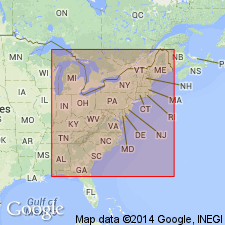
- Usage in publication:
-
- Phenix City Gneiss
- Modifications:
-
- Named
- Dominant lithology:
-
- Gneiss
- AAPG geologic province:
-
- Piedmont-Blue Ridge province
Summary:
Named as part of Uchee Complex (new name) within Uchee block of AL Piedmont. Named for Phenix City, Russell Co., east-central AL. Type locality is excellent exposures on Chattahoochee River at Phenix City. Consists of coarsely crystalline, highly contorted migmatite gneiss. Migmatite is composed of biotite-epidote quartz diorite gneiss, biotite-hornblende gneiss, and local epidote-biotite amphibolite. Characterized in places by large (2 in.) calcite crystals. Relationship to Moffits Mill Complex, also of Uchee block, is unclear due to poor preservation of rock and partial cover of contact area by Cretaceous sediments. Age is early Paleozoic.
Source: GNU records (USGS DDS-6; Reston GNULEX).

- Usage in publication:
-
- Phenix City Gneiss
- Modifications:
-
- Overview
- AAPG geologic province:
-
- Piedmont-Blue Ridge province
Summary:
Type locality refined as exposures at Rocky Shoals on Chattahoochee River at Phenix City.
Source: GNU records (USGS DDS-6; Reston GNULEX).

- Usage in publication:
-
- Phenix City Gneiss
- Modifications:
-
- Overview
- AAPG geologic province:
-
- Piedmont-Blue Ridge province
Summary:
Authors follow terminology of Bentley and Neathery (1970) for this report. Uchee Complex of the Uchee belt consists of Mulberry Gneiss, Phenix City Gneiss, informal Standing Boy quartz diorite (combined with Phenix City Gneiss in figures) and informal Hudson Rapids Amphibolite (combined with other amphibolites in figures). Age is early Paleozoic. Report includes geologic sketch map. [Remark reflects published version. GNU review requested inverted usage for informal terms, but request was not followed by authors. Mulberry Standing Boy, and Hudson Rapids units should remain informal terms.]
Source: GNU records (USGS DDS-6; Reston GNULEX).

- Usage in publication:
-
- Phenix City Gneiss*
- Modifications:
-
- Age modified
- AAPG geologic province:
-
- Piedmont-Blue Ridge province
Summary:
Age of Phenix City Gneiss is Late Proterozoic and Early Cambrian based on radiometric ages cited by G.S. Russell (1985, Reconnaissance geochronological investigations of the Phenix City Gneiss and Bartletts Ferry mylonite zone, IN Kish, S.A., Hanley, T.B., and Schamel, S., eds., Geology of the southwestern Piedmont of Georgia: Tallahassee, Florida State University, Department of Geology, p. 9-11.).
Source: GNU records (USGS DDS-6; Reston GNULEX).
For more information, please contact Nancy Stamm, Geologic Names Committee Secretary.
Asterisk (*) indicates published by U.S. Geological Survey authors.
"No current usage" (†) implies that a name has been abandoned or has fallen into disuse. Former usage and, if known, replacement name given in parentheses ( ).
Slash (/) indicates name conflicts with nomenclatural guidelines (CSN, 1933; ACSN, 1961, 1970; NACSN, 1983, 2005, 2021). May be explained within brackets ([ ]).

